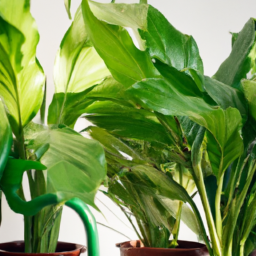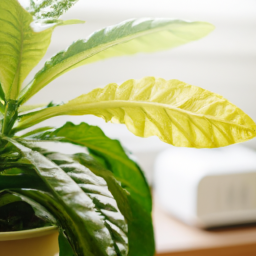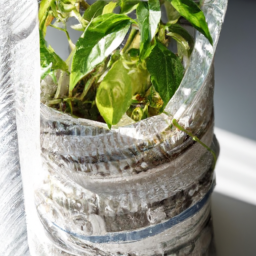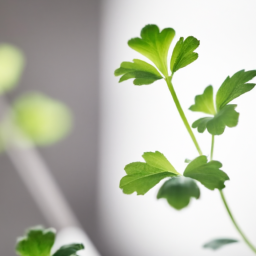
Are you looking for the best grow light for houseplants to help your indoor greenery thrive? Look no further! Finding the right grow light can make a world of difference in the health and growth of your beloved plants. Whether you’re a seasoned plant parent or just starting out, having the right lighting setup is essential for ensuring your houseplants get the light they need to flourish. In this blog post, we’ll explore some of the top options on the market and help you choose the best grow light for your indoor garden. Let’s shed some light on this important topic!
Top Features to Look for in the Best Grow Light for Houseplants
Understanding the Importance of Grow Lights
When it comes to growing houseplants indoors, providing them with the right amount of light is crucial for their health and growth. While natural sunlight is the best source of light for plants, not all indoor spaces receive adequate sunlight throughout the day. This is where grow lights come in handy. Grow lights are artificial light sources that are designed to mimic the natural light spectrum that plants need for photosynthesis. There are a variety of grow lights available on the market, but not all of them are created equal. When choosing the best grow light for your houseplants, there are several key features to consider.
One of the most important features to look for in a grow light is the light spectrum it emits. Different plants have different light requirements, so it’s essential to choose a grow light that provides the right spectrum for the plants you are growing. Most plants require a full spectrum light that includes both blue and red light wavelengths, as these are the most important for plant growth. Look for a grow light that offers a balanced spectrum to ensure that your plants receive the light they need to thrive.
Another important feature to consider when choosing a grow light is its intensity. The intensity of a grow light is measured in terms of lumens or lux, and it determines how bright the light is. Different plants have different light intensity requirements, so it’s essential to choose a grow light that provides the right level of brightness for your plants. In general, flowering plants require higher light intensity than foliage plants, so keep this in mind when selecting a grow light for your houseplants.
The third key feature to look for in a grow light is its energy efficiency. Grow lights can consume a significant amount of electricity, so it’s important to choose a light that is energy-efficient to save on energy costs in the long run. Look for grow lights that are LED or fluorescent, as these types of lights are known for their energy efficiency. LED grow lights, in particular, are highly energy-efficient and can last for many years without needing to be replaced. By choosing an energy-efficient grow light, you can provide your plants with the light they need while also reducing your carbon footprint.
Choosing the Right Type of Grow Light
When it comes to choosing the right type of grow light for your houseplants, there are several options to consider. The most common types of grow lights are fluorescent, LED, and HID (high-intensity discharge) lights. Each type of grow light has its own advantages and disadvantages, so it’s important to choose the one that best suits your needs.
Fluorescent grow lights are a popular choice for indoor gardeners because they are affordable, easy to install, and provide a good spectrum of light for plants. However, fluorescent lights are not as energy-efficient as LED lights and may need to be replaced more frequently. LED grow lights, on the other hand, are more expensive upfront but are highly energy-efficient and long-lasting. LED lights also produce less heat than other types of grow lights, making them a safer option for indoor use.
HID grow lights are another option to consider, especially for larger indoor gardens. HID lights are extremely bright and powerful, making them ideal for plants that require high light intensity, such as flowering plants. However, HID lights can be expensive to operate and may produce a significant amount of heat, so proper ventilation is essential when using them. When choosing the right type of grow light for your houseplants, consider factors such as the size of your indoor garden, the light requirements of your plants, and your budget.
In addition to the type of grow light, you should also consider the size and shape of the light fixture. Choose a grow light that is the right size for your indoor garden and can be easily adjusted to provide light to all of your plants. Some grow lights come with adjustable height settings or swivel heads, allowing you to customize the light distribution for your specific needs. Consider the layout of your indoor garden and the placement of your plants when choosing a grow light to ensure that all of your plants receive adequate light for healthy growth.
Tips for Using Grow Lights Effectively
Once you have chosen the best grow light for your houseplants, there are a few tips to keep in mind to ensure that your plants thrive. First, it’s important to position the grow light at the correct distance from your plants. Most grow lights come with manufacturer recommendations for the optimal distance, so be sure to follow these guidelines to prevent burning or shading your plants.
It’s also essential to provide your plants with a consistent light schedule. Most houseplants require around 12-16 hours of light per day, so set a timer or schedule to ensure that your plants receive the right amount of light each day. Be sure to adjust the light schedule as needed based on the growth stage of your plants, as they may require more or less light during different phases of growth.
Finally, regularly monitor the health and growth of your plants to ensure that they are receiving the right amount of light. If you notice any signs of light deficiency, such as yellowing leaves or stunted growth, adjust the light intensity or duration accordingly. By following these tips and choosing the best grow light for your houseplants, you can create a thriving indoor garden that flourishes year-round.

Comparing Different Types of Grow Lights for Houseplants
Fluorescent Grow Lights
Fluorescent grow lights are a popular choice for houseplants because they are affordable and energy-efficient. There are two main types of fluorescent grow lights: T5 and T8. T5 lights are more efficient and produce more light than T8 lights, making them a better choice for plants that require high light levels. T8 lights are less expensive and still provide adequate light for most houseplants.
When choosing fluorescent grow lights, it is important to consider the color temperature. Cool white fluorescent lights are best for promoting vegetative growth, while warm white lights are better for flowering and fruiting plants. It is recommended to use a combination of both cool and warm white lights to provide a full spectrum of light for your houseplants.
Another factor to consider when using fluorescent grow lights is the distance between the light and the plants. Most houseplants require 12-18 hours of light per day, so it is important to position the lights close enough to provide adequate light without burning the plants. It is recommended to keep the lights 6-12 inches above the plants for optimal growth.
In conclusion, fluorescent grow lights are a great option for houseplants because they are affordable, energy-efficient, and provide a full spectrum of light. By choosing the right type of fluorescent lights and adjusting the distance from the plants, you can help your houseplants thrive indoors.
LED Grow Lights
LED grow lights are becoming increasingly popular for houseplants because they are energy-efficient and produce less heat than traditional grow lights. LED lights are available in a wide range of colors, allowing you to customize the light spectrum for your specific plants’ needs. They also have a long lifespan, making them a cost-effective option in the long run.
When choosing LED grow lights for your houseplants, it is important to consider the wattage and color spectrum. Higher wattage lights are better for plants that require high light levels, while lower wattage lights are suitable for plants that need less light. It is recommended to choose LED lights with a full spectrum of colors to promote healthy growth in your houseplants.
One of the main advantages of LED grow lights is their durability and long lifespan. LED lights can last up to 50,000 hours, compared to fluorescent lights that last around 10,000 hours. This makes LED lights a great investment for long-term plant growth and maintenance.
In conclusion, LED grow lights are a great option for houseplants because they are energy-efficient, customizable, and long-lasting. By choosing the right wattage and color spectrum for your plants’ needs, you can help them thrive indoors with the help of LED grow lights.
High-Intensity Discharge (HID) Grow Lights
High-Intensity Discharge (HID) grow lights are another popular option for houseplants because they provide intense light levels that promote healthy growth. There are two main types of HID lights: metal halide (MH) and high-pressure sodium (HPS). MH lights are best for promoting vegetative growth, while HPS lights are better for flowering and fruiting plants.
When using HID grow lights for houseplants, it is important to consider the heat output and distance from the plants. HID lights produce a lot of heat, so it is important to position them at least 12-18 inches above the plants to prevent burning. It is also recommended to use a reflective hood to maximize the light output and coverage for your houseplants.
Another factor to consider when using HID grow lights is the lifespan and cost. HID lights have a shorter lifespan compared to LED lights, typically lasting around 10,000 hours. They are also more expensive to operate in the long run due to their higher energy consumption. However, HID lights are still a popular choice for growers who need intense light levels for their plants.
In conclusion, HID grow lights are a great option for houseplants that require high light levels for healthy growth. By choosing the right type of HID lights and adjusting the distance from the plants, you can help your houseplants thrive indoors with the help of HID grow lights.

Reviews of the Top-Rated Grow Lights for Houseplants
Are you looking to give your houseplants the best possible environment to thrive in? One of the most important factors in ensuring healthy growth for your indoor plants is providing them with adequate light. While natural sunlight is always the best option, sometimes it’s just not enough, especially during the winter months or if your plants are located in a room with limited natural light. That’s where grow lights come in handy. In this article, we’ll review some of the top-rated grow lights for houseplants to help you make an informed decision.
1. Roleadro LED Grow Light
The Roleadro LED Grow Light is a popular choice among plant enthusiasts for its high performance and energy efficiency. This grow light features a full spectrum of light that mimics natural sunlight, promoting healthy growth and blooming for your houseplants. It also comes with a timer function, allowing you to set the light to turn on and off at specific times, making it convenient to use.
One of the standout features of the Roleadro LED Grow Light is its low heat output, which helps prevent your plants from getting burned. It’s also easy to install and adjust, making it suitable for beginners and experienced growers alike. With its durable construction and long lifespan, this grow light is a great investment for anyone looking to improve their indoor gardening setup.
In terms of price, the Roleadro LED Grow Light is relatively affordable compared to other options on the market. It’s a cost-effective solution for providing your houseplants with the light they need to thrive, making it a top choice for many plant lovers.
2. Spider Farmer SF-2000 LED Grow Light
The Spider Farmer SF-2000 LED Grow Light is another top-rated option for those looking to enhance their indoor gardening experience. This grow light features a high-efficiency Samsung LM301B diode board, providing your plants with a full spectrum of light for optimal growth and flowering. It also comes with a dimming knob, allowing you to adjust the light intensity according to your plants’ needs.
One of the key benefits of the Spider Farmer SF-2000 LED Grow Light is its energy efficiency, helping you save on electricity costs while providing your plants with the light they need to thrive. It’s also designed with a waterproof and dustproof construction, making it durable and long-lasting. With its easy installation and user-friendly design, this grow light is a great choice for both beginners and experienced growers.
While the Spider Farmer SF-2000 LED Grow Light is priced higher than some other options on the market, its high performance and quality construction make it a worthwhile investment for anyone serious about indoor gardening. If you’re looking for a reliable and efficient grow light for your houseplants, this is definitely one to consider.
3. Phlizon 1200W LED Plant Grow Light
The Phlizon 1200W LED Plant Grow Light is a top contender in the grow light market, known for its high power output and excellent coverage area. This grow light features a full spectrum of light, including red, blue, white, and UV, providing your plants with the ideal conditions for photosynthesis and growth. It also comes with a daisy chain feature, allowing you to connect multiple lights together for increased coverage.
One of the standout features of the Phlizon 1200W LED Plant Grow Light is its high PAR value, ensuring that your plants receive the right amount of light for healthy growth and blooming. It’s also designed with a quiet cooling fan and aluminum heat sink, helping to dissipate heat and prevent your plants from getting burned. With its easy-to-use design and durable construction, this grow light is a top choice for indoor gardeners.
While the Phlizon 1200W LED Plant Grow Light may be on the higher end in terms of price, its high power output and wide coverage area make it a worthwhile investment for serious plant enthusiasts. If you’re looking for a reliable and efficient grow light to help your houseplants thrive, this is definitely one to consider.
I’ll leave you with these final thoughts
Are you looking to bring some greenery into your home but struggling to find the perfect grow light for your houseplants? Look no further! In this blog post, we will discuss the best grow light options for your indoor plants to thrive and flourish.
When it comes to choosing a grow light for your houseplants, there are a few key factors to consider. LED grow lights are a popular choice for their energy efficiency and customizable spectrum options. They are also long-lasting and produce less heat, making them ideal for indoor plants. Another great option is fluorescent grow lights, which are affordable and provide a good balance of light for most houseplants. Whichever type of grow light you choose, make sure to consider the specific needs of your plants and adjust the light intensity and duration accordingly. With the right grow light, your indoor plants will be sure to thrive and bring a touch of nature into your home.
Check Out These FAQs:
Q1: What factors should I consider when choosing the best grow light for my houseplants?
A1: When choosing a grow light for your houseplants, consider factors such as the type of plants you have, the size of your space, the light intensity needed, and the duration of light exposure required.
Q2: What are the different types of grow lights available for houseplants?
A2: There are various types of grow lights available for houseplants, including fluorescent, LED, and high-intensity discharge (HID) lights. Each type has its own benefits and drawbacks, so it’s important to choose the one that best suits your needs.
Q3: How can I determine the right light intensity for my houseplants?
A3: The light intensity needed for your houseplants depends on the type of plants you have. Generally, plants that require high light levels, such as succulents and cacti, will need a higher light intensity compared to plants that prefer low light levels, like ferns and ivy.
Q4: How long should I leave the grow light on for my houseplants?
A4: The duration of light exposure needed for your houseplants will vary depending on the type of plants you have. In general, most houseplants require around 12-16 hours of light per day. It’s important to mimic natural daylight cycles to promote healthy growth.
Q5: Are there any specific features I should look for in a grow light for houseplants?
A5: When choosing a grow light for your houseplants, look for features such as adjustable light intensity, a timer function, and energy efficiency. These features will help you customize the light exposure for your plants and ensure they receive the right amount of light for optimal growth.
Dr. Olivia Green is a botanist with over two decades of experience in indoor plant cultivation. She holds a Ph.D. in Plant Biology and has dedicated her career to researching plant behavior in controlled environments. Dr. Green is passionate about helping plant enthusiasts master the art of indoor gardening through her extensive knowledge and practical insights.


